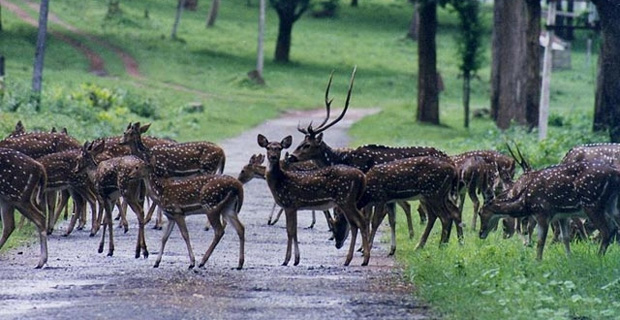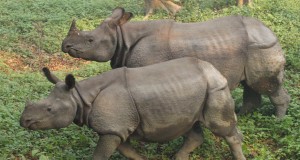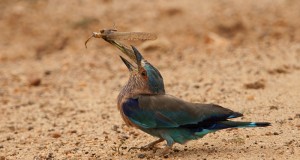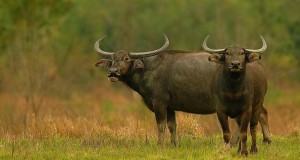Tall trees, swaying bamboos and grassy expanses. Calls of mynas and drongos that pierce the gentle murmur of forest streams. A herd of gaur in the morning sun, with massive horned heads and pale green eyes that stare back at you. A blazing afternoon. A pack of wild dogs corners a chital stag in a forest pool. An elephant herd frolicks in water as the setting sun bathes it in gold. As night falls, the haunting cry of a peacock retiring to the top of a tall, leafless tree. A sambar calls in alarm. A tiger is on the move, leaving his tracks on a dusty trail.
This is typical South Indian jungle. Most of it is gone forever. Yet in the vast forests of the Mysore plateau in Karnataka state that stretch between the towering Western Ghats and Nilgiri mountains, the experience comes alive even now.
Administered separately, Nagarahole (pronounced Naagara-ho1a) and Bandipur are but two faces of a single spectacular ecological continuum that also includes Mudumalai and Wynad wildlife sanctuaries in the neighboring states. The 333-sq-mile (865-sq-km) Bandipur National Park lies south of the Kabini river which meanders through the jungle, while Nagarahole (247 sq mile/ 640 sq km, including proposed expansion) is to its north. The old royal capital city of Mysore is the gateway to both parks.
Due to their geographic proximity the two parks share many features. The balmy climate is common to both. So are most of the plant and animal species. Yet, there are differences too.
The Bandipur that the tourist sees is an open, grassy woodland. The jungles of Nagarahole are taller and denser. Bandipur has superb scenery of mountains, gorges and undisturbed forests. Nagarahole has an astonishing abundance of wildlife. Together, these two parks cover more than 580 sq miles (1500 sq km). About a third of this area has been demarcated as the “Wilderness Zone” in which all disturbances, including tourism and forestry, are prohibited. The facilities for wildlife tourism have been developed in the three “tourism zones.” Two of these, called Nagarahole and Karapura are in Nagarahole National Park while the third is in Bandipur. Two more tourism zones, at Begur in Bandipur and Moorkal in Nagarahole are being planned.
astonishing abundance of wildlife. Together, these two parks cover more than 580 sq miles (1500 sq km). About a third of this area has been demarcated as the “Wilderness Zone” in which all disturbances, including tourism and forestry, are prohibited. The facilities for wildlife tourism have been developed in the three “tourism zones.” Two of these, called Nagarahole and Karapura are in Nagarahole National Park while the third is in Bandipur. Two more tourism zones, at Begur in Bandipur and Moorkal in Nagarahole are being planned.
Climate and Landscape: Three seasons are usually recognized. The wet season or monsoon lasts from June to September. The cool season that follows lasts up to January.
The hot season or summer extends from February to May. However, seasonal variations of temperature are quite moderate, ranging between 59°F ( 15°C ) at the coldest to about 82°F (28°C) at the hottest. Annual rainfall is lowest at the eastern edge of Bandipur — 32 inches (80 cm). It increases gradually as you proceed in a northwesterly direction, reaching about 60 inches (150 cm) at the western edge of Nagarahole. The landscape is generally one of gentle slopes and shallow valleys at an average altitude of 2300 feet (700 meters). A few peaks are higher, Gopalaswamy Betta (4770 feet/ 1454 meters) in B andipur Park being the highest.
andipur Park being the highest.
Kabini, a tributary of the mighty Cauvery, is the largest river draining this tract. Other important rivers are the Moyar and Mulehole (both in Bandipur), the Lakshmana Teertha and Nagarahole—the last name meaning “Cobra River.” An irrigation dam was built across the Kabini in 1974, creating the picturesque lake that separates the two parks.
Two basic types of tropical, mixed deciduous forests clothe the  region. Of these, the moist deciduous type, usually occurring in localities getting a rainfall higher than 48 inches (120 cm), is found in the northern and western parts of Nagarahole Park as well as on the western fringes of Bandipur.
region. Of these, the moist deciduous type, usually occurring in localities getting a rainfall higher than 48 inches (120 cm), is found in the northern and western parts of Nagarahole Park as well as on the western fringes of Bandipur.
The dry deciduous type covers the southeastern part of Nagarahole and most of Bandipur. Interestingly, unlike the temperate zone forests, these tropical deciduous forests are leafless in summer rather than in winter. The period of leaf fall, essentially an ecological adaptation to cope with water stress, is relatively shorter in the moist type when compared to the dry.
The moist deciduous forests are tall and dense. The tree canopy is usually twostoried. The upper canopy, about 98 feet (30 meters) tall, is dominated by valuable timber trees such as mathi (Terminalia iomeniosa), nandi (Lagersiroemia lanceolaia), honne ( Pierocarpus marsupium) and tadasalu ( Grewia tilaefolia ). These jungles are reputed as the home of the two most expensive timbers — dark, shiny rosewood ( Dalhergia latifolia) and the rich, grainy teak ( Teciona grandis). The lower forest canopy has the prolific fruit yielders — nelli kooli ( Gonclina arho(PhyIlanihus emhlica), rea), kadu tega (Dilienia peniagyna) and the Sandia S-all of which attract a host of animals and birds. Bende ( Kydia calycina), whose bark is a great favorite with elephants, is ubiquitous.
Lower down, the shrub layer is usually very dense and varied in composition.
However, in recent decades runaway exotic shrubs like lantana and lupatorium have established dominance, aggressively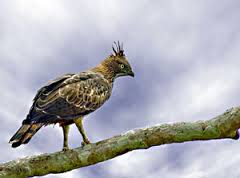 invading openings created by logging. In the moist deciduous forests grass growth is not very profuse where the trees and shrubs are dense. But in cleared openings a variety of grasses grow.
invading openings created by logging. In the moist deciduous forests grass growth is not very profuse where the trees and shrubs are dense. But in cleared openings a variety of grasses grow.
A unique feature of these moist deciduous forests, particularly in Nagarahole, are the open swamps alled hadlus.
Here the soil is clayey, perennially moist, and supports a luxuriant growth of green grass all the year round. These are ideal spots to watch large concentrations of ungulates, particularly gaur.
The dry deciduous forest type is strikingly different. The canopy is lower, trees are more widely spaced and their trunks are usually stunted and crooked. Many species of the moist type are present but their relative dominance varies. Dindalu (Anogeicsus lattfolia) is usually the commonest tree. Kakke ( Cassia fistula), “Flame of the Forest” ( Butea monosperma) and bamboo (Dendrocalmus sirictus) are all commoners. The second canopy is barely discernible. There are open grassland patches and the entire habitat has a woodland savannah-like appearance. In summer forage and water scarcity pose serious problems to the herbivores.
An even more harsh environment is found around the Moyar Gorge at the easternmost edge of Bandipur. In this region of lowest rainfall, dry deciduous forest gives way to an even poorer, stunted scrub type. The soil is rocky and barren and the vegetation dominated by thorny plants.
Elephants and Others: The Nagarahole- Bandipur forests are perhaps one of the best remaining habitats of the Asian elephant ( Elephas maxims ) in the world. Over a thousand of these mighty beasts are estimated to range over this tract. A striking ecological feature of these elephant populations is their seasonal migration. In the wet season when water and forage are plentiful everywhere, the elephants are evenly distributed. This is the best time to see huge herds of them in the open forests of Bandipur. As the cool season ends  and summer sets in, water and forage availability becomes restricted. Elephants congregate around specific localities like the banks of Mule-hole river, Nagarahole Tourism Zone, and, above all, the banks of the Kabini.
and summer sets in, water and forage availability becomes restricted. Elephants congregate around specific localities like the banks of Mule-hole river, Nagarahole Tourism Zone, and, above all, the banks of the Kabini.
Setting out on a jeep ride from Karapura you can reach a place called Mastigudi on the banks of the Kabini around sunset to witness a scene reminiscent of Africa rather than Asia. A breathtaking panoramic sweep of a mile-long stretch of the river is dotted with elephants — over a hundred of them. If you arc lucky you might even see a herd swimming across, the adults carefully chaperoning the “little” babies. During the 19th Century, G. P. Sanderson developed the khedda (stockade) method of capturing elephants at this site. Though the medieval barbarity of the khedda is mercifully a thing of the past in this conservation-conscious age, we get a glimpse of it when the waters of the Kabini recede and the remnants of the old stockade are revealed.
Caur ( Bos gaurus), largest of the wild bovids, are another attraction in these parks. Though they are still recovering from a population crash caused by rinderpest disease in 1968, gaur are a common sight at Nagarahole and Karapura, though not in Bandipur yet. Herds of 20-30 animals or, sometimes, massive solitary bulls, can be seen placidly grazing as you pass by in a jeep.
Four species of deer inhabit these forests. The largest of them is the sambar (Census unicolor), a shy creature preferring thick cover and becoming active late in the evening. One usually tends to underestimate their abundance in any area. The usual sighting is of two or three animals, normally a mother with her young. During the wet season, occasionally, large temporary associations of 10-20 sambar are seen. Very large stags with fine antlers are also seen in Bandipur.
The commonest deer in both parks is the chital or axis deer ( Axis axis). These handsome spotted deer are so numerous around the park headquarters at them atter a while. rhey are also the least shy species, congregating around the tourist rest houses at night, perhaps to avoid predators. Being partial to open grassy areas, chital are most often seen in the cleared “view-lines” bordering the “game roads.”  Human intrusions, such as opening up dense forests, clearing view-lines and creating water holes, have all obviously benefited chital which tend to be less numerous in the denser more “natural” forests.
Human intrusions, such as opening up dense forests, clearing view-lines and creating water holes, have all obviously benefited chital which tend to be less numerous in the denser more “natural” forests.
Muntjac ( Mumtiacus muntjac) are small goat-sized, reddish-fawn-colored deer with a surprisingly loud bark that carries long distances in the stillness of the night, warning everyone about predators on the prowl. So the muntjac is also known as the barking deer. This alert little sentinel of the forest prefers the edge of dense cover venturing out only to graze or eat fallen over-ripe fruit.
Usually, one gets only a fleeting glimpse of muntjac dashing for cover. But on the Nagaraja Game Road in Nagarahole muntjacs have become accustomed to tourists and can be seen at close quarters.
Chevrotain or mouse deer ( Tragulus meminna) are tiny, rabbit-sized, evolutionarily primitive kind of deer. Though they appear to be reasonably common, going by the evidence of their tracks, they are rarely seen by tourists because of their entirely nocturnal habits.
The four-horned antelope ( Tetracerus quadricormis ) is perhaps the most interesting ungulate in these parks. About the size of the muntjac, but with longer legs, it has a duller brownish coat. The male four-horned antelope has two spiky horns in the usual place and two extra rudimentary knobs set a little forward, giving the species the unique distinction of being the only four-horned animal in the world. It is a thinly distributed species which prefers open, dry, hilly terrain and is uncommon everywhere. Very little is known about its ecology but it is not found in the denser moist forest of Nagarahole.
Unfortunately, most park staff who accompany the tourists do not distinguish it from the muntjac though it is seen often on the Russel Fireline Road of the Karapura and Moyar area of Bandipur.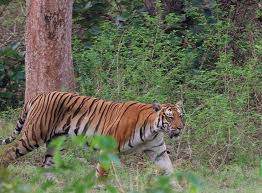
Wild pig (Sus scrofa) and blacknaped hare (Lepus migricollis) are two other common herbivores. The Indian porcupine ( Hystrix imdica) and pangolin (Manis crassicaudata) are two other species not commonly seen because they are nocturnal.
The former is a rodent with a catholic diet that includes the antlers that deer shed annually. The latter relies on an exclusive diet of ants and termites. Other mammals worth mentioning are the handsome red giant squirrel ( Ratufa indica), large brown flying squirrel ( Petaurista petaurista), giant fruit bat ( Pteropus giganteus), and the secretive slender loris (Loris tardigradus).
Except the giant squirrel, these are all nocturnal and usually heard rather than seen.
Living up in the tree canopy are two kinds of monkeys. The Hanuman langur (Presentellus) is a longtailed leaf-eating species, extremely common in both parks. The bonnet macaque ( Macaea radiata) is a versatile feeder common around human settlements but rare in the deep jungle. The Hunters: Among carnivores the least predatory animal is the sloth bear ( Melursus ursinus). It feeds mainly on termites, vegetable matter, honey and, occasionally, carrion. This short-sighted creature is sometimes preyed upon by the other large carnivores! Though bears are seen in all the areas, the best place to sight them is the Karapura Tourism Zone. If lucky you may see a mother sloth bear taking her cubs piggy-back — an amusing sight.
With such a large and diverse assemblage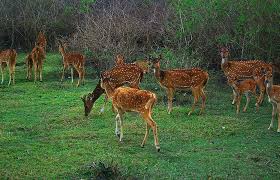 of prey species, the Nagarahole-Bandipur forests naturally harbor many predators. Tiger ( Panthera tigrish), leopard ( Panthera pardus ), and the Asiatic wild dog ( Cuon alpinus) also called dhole, all coexist in these parks.
of prey species, the Nagarahole-Bandipur forests naturally harbor many predators. Tiger ( Panthera tigrish), leopard ( Panthera pardus ), and the Asiatic wild dog ( Cuon alpinus) also called dhole, all coexist in these parks.
Though Bandipur is one among the nine originally constituted Project Tiger Reserves, interestingly it is Nagarahole that is the stronghold of the tiger. Intensive protection, dense concentrations of large ungulate prey and dense cover, ideal for the stalking predator, have all combined to create what is perhaps the finest tiger habitat in South India. Heavy predation on gaur, including large solitary hulls, by the tiger is a special feature of Nagarahole. Yet you must remember that even here seeing a tiger in daylight is not as easy as it is in some North Indian parks. Strict avoidance of artificial baiting and the consequent lack of acclimatization to tourism is perhaps one of the reasons why an encounter with a tiger is a chancy event in Nagarahole. Tiger sightings are even more difficult in Karapura and quite extraordinary events in Bandipur.
However, if you are interested in the leopard, Karapura is undoubtedly the place to go. The forest there supports a high density of the leopard’s favorite prey — the langur monkey. Leopards can be usually seen at fairly close range during an evening jeep drive, unless you are very noisy. The wild dog is a reddish, spaniel-sized, pack-hunting canid. Unlike tigers and leopards which stalk their prey in dense cover, wild dogs course after their prey, which is usually chital or sambar. Because wild dogs hunt mainly during the day and prefer open areas suitable for coursing they are seen fairly often by tourists. Bandipur is the best place to see them, followed by Nagarahole and Karapura. The striped hyena ( Hyaena hyaena), another large carnivore, is found very rarely in the scrub forests of eastern Bandipur. Reported to be more a scavenger than a hunter, it is generally not seen by tourists.
A host of smaller carnivores are also present. The diminutive jackal (Canis aureus) is the only other canid, apart from the dhole. There are three species of lesser cats: the jungle cat (Felis ehaus), the leopard cat ( Fells bengalensis) and the rare rusty spotted cat (Delis rubiginosa) — all are nocturnal; two species of civets, the perfumeyielding small Indian civet (Vivericula indica) and the arboreal palm civet ( Paradoxurus hermaphroditus ), which are also nocturnal; four species of mongooses, the common ( Herpestes edwardsi), the stripe-necked ( Herpestes vitticollis), the brown ( Herpestes fuscous) and the ruddy ( Herpestes smithii) — are found in the tract but identifying them in the field takes some practice. The common otter (Sutra sutra) is the only mustalid recorded in both parks. Groups of otters can sometimes be seen in the Kabini reservoir.
Birds: The Nagarahole-Bandipur region is rich territory for bird watchers. An incomplete checklist of birds exceeds two hundred entries. The backwaters of the Kahini sustain huge gatherings of cormorants, teals, ducks, herons and waders.
The abundance of fish there, including the large masheer (Tor tor), attracts a number of ospreys (Pandit haliaetus) and grayheaded fishing eagles (lethyophaga ichth-vaetus ). Among other birds of prey, the crested hawk eagle ( Spizaels cirrhatus), serpent eagle (Spilornis cheela) and honey buzzard (Pernis ptilorhyneus ) are all common. The shaheen falcon (Falco peregrinus), hobby ( Falco .suhbuteo) and the spectacular king vulture (Sarcogyps calvus) are some rarer birds of prey seen in the area.
Among game birds, peafowl (Pavo en-status), gray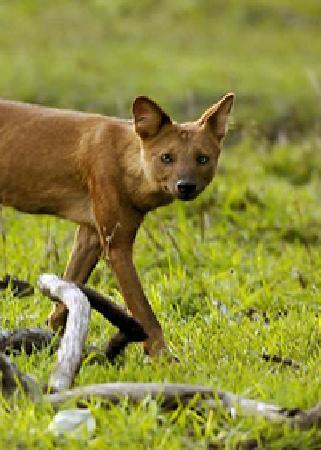 jungle fowl (Gallus sonneralti) and the quarrelsome red spurfowl (Galloperdix spadicea) are usually seen in the forest while the gray partridge (Francolinus pondicerianus) prefers the scrub on the fringes.
jungle fowl (Gallus sonneralti) and the quarrelsome red spurfowl (Galloperdix spadicea) are usually seen in the forest while the gray partridge (Francolinus pondicerianus) prefers the scrub on the fringes.
The other colorful or uncommon birds seen in these forests are: Malabar trogon ( Harpactes facials ), blue-bearded bee eater (Nyctyornis athertti), Malabar pied hornbill ( Anthracoceros cortals), great black woodpecker ( Dryocopus javensis), Alexandrine parakeet ( Psittacula eupatria), lesser coucal (Centropus toulou), Indian pitta (Pitta brachyura ), scarlet minivet ( Pricrocols flammeus), fairy blue bird (Irena pulled), scimitar babbler ( Promatorhinus horsfieldii), paradise flycatcher ( Tersiphte paradisi), Malabar whistling thrush (Myiophtous horsfieldii), green i mperial pigeon ( Ducula aenea) and yellowlegged green pigeon ( Treron phoenicoptera).
The racket tailed drongo ( Dicrurus paradiscus) and hill myna (Gracula religiosa) are the noisy birds of the day while the owls and nightjars are heard at night.
Unfortunately, the tourist cannot wander around on foot in the forests to watch birds.
Considering the dangers of encounters with elephants, the park authorities have wisely forbidden such explorations. So the birdwatching is generally confined to the vicinity of rest houses and to the jungle safaris on vehicles. The early morning coracle ride from Karapura provides absolutely fantastic opportunities for bird-watching.
Reptiles: Coracle rides on the Kabini may occasionally yield sightings of marsh crocodile (rocodilus palustrus) also. The other large reptile, the monitor lizard ( Varanus bengalensis) is sometimes seen in the forests. Several species of snakes including rock python ( Python molurus), cobra (Naja naja), rat snake (Plyas mucosus), wolf snake (Lycodon aulicus), vine snake (Anaetulla nasls), common krait ( Bungarus cacruleus), Russel’s viper ( Vipera russelli), green keelback ( Macrophisthadon plumbicolor) and bamboo pit viper ( Trirneresurus grarnineus) are also found.
The reptilean and amphibian fauna of the region include a variety of turtles and frogs also. To complete the picture there is a tremendous abundance and diversity of insect life, including many colorful butterfly species.
Getting the Most out of Your Trip: Of the three choices that are available (Bandipur, Karapura and Nagarahole) to you to sample the splendors of the wildlife of the region, it is preferable to choose one or two if you have only limited time at your disposal. Two to three days are needed to derive full benefit from a visit to any one of the three. If your visit coincides with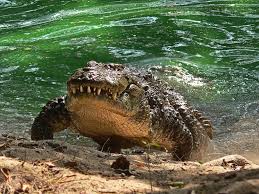 the peak of the monsoon, Bandipur is the best choice because of its better accessibility and wildlife viewing possibilities. In .June and July Nagarahole and, to a lesser extent, Karapura become rain-soaked and the roads often become so muddy that you may find yourself confined to your rest house.
the peak of the monsoon, Bandipur is the best choice because of its better accessibility and wildlife viewing possibilities. In .June and July Nagarahole and, to a lesser extent, Karapura become rain-soaked and the roads often become so muddy that you may find yourself confined to your rest house.
The forests are lush and green in the wet season. The skies are bright blue and the weather sunny and cool between October and January. But the animals are widely dispersed and, because of the dense undergrowth, are harder to view, particularly in Nagarahole and Karapura. During the dry season, animal sightings are excellent in Nagarahole and Karapura, but generally poor in Bandipur. However, the forests are leafless and bone dry in this season.
It is important to plan your trip well in advance because accommodation is very limited in these parks and at least a month’s advance reservation is advisable. It is better to avoid weekend visits to Bandipur or Nagarahole because the heavy influx of tourists, many of them merely misguided picnickers, detracts from quality of the experience for the keen wildlifer. Accommodation is hardest to get in Nagarahole, followed by Bandipur and Karapura in that order. The first two cater to the needs of a large number of domestic tourists and are priced accordingly. On the other hand, Karapura, though more expensive, is fully geared to meet the needs of a more exclusive clientele. The Kabini River Lodge there, with its vast wooded compound, splendid lakeside scenery and gracious old-world air is well organized and uncrowded when compared to the rest houses in Nagarahole or Bandipur. Reservations are also easier to make because of its connections with the network of private travel operators. In Bandipur and Nagarahole reasonably priced Indian food is available at a couple of hours’ notice. At Karapura there is usually an excellent Indian or Western menu to choose from. There is also a well-stocked bar, unlike the other two places where you will have to carry your own liquor. The quality of rooms and service is also far superior at the Kabini Lodge. If you have booked your accommodation at Nagarahole, you very rarely run the risk of a last-minute cancellation because of a visiting VIP.
Bandipur is about 50 miles (80 km) from Mysore city and is on the excellent highway that goes on to Ooty. It is well connected by buses to both places. There are only one or two buses a day that run between Mysore and Nagarahole, covering the distance in about three hours. Karapura is the most difficult to reach on such public transport.
Though a few buses running between Mysore and Manandawadi in Kerala pass through it after a painful three to four hour journey from Mysore, a one-mile walk to the Kabini Lodge awaits you. For a visitor short on time a two-hour taxi ride from Mysore is the most convenient way to reach any one of these three places. Even though Bandipur and Karapura can be reached at any time of the day, you will have to enter Nagarahole before six in the evening because the route is closed to all traffic at night. In any case, it is better to reach early rather than risk encountering an elephant roadblock late in the evening.
In all three places, tourists are taken into the forest to see wildlife in jeeps or vans between 6 and 9 a.m. and between 4 and 6 p.m. These trips are on specially laid-out dirt roads called “game roads” which usually pass close to grazing areas, salt licks and water holes. The undergrowth is cleared to a distance of about 32 yards (30 meters) on either side to improve visibility and to attract herbivores to the sprouting grass.
Usually an excellent view of most common species can be had at a range of 15 to 20 yards (14-18 meters) particularly if total silence is observed by all the passengers in the vehicle. The experienced drivers of these vehicles generally keep at a safe distance from elephants. A Park Guard accompanies the visitors and is reasonably good at spotting large animals. As a rule he is quite useless at identifying birds and smaller mammals. The trained naturalists of the Kabini Lodge who accompany tourists in Karapura are far better in this respect. You are strictly prohibited from getting down from the vehicle. The jungle ride usually lasts about an hour and a half and payment is on the basis of distance traveled.
Short jungle rides on elephant back are available only in Bandipur. Though you see very little wildlife this way you get a good feel of the jungle. Kabini Lodge offers facilities of coracle rides on the river. (A coracle is a round-country boat made of bamboo and buffalo hide.) Special permission from the park authorities is needed for the use of watchtowers in the forests.
Apart from wildlife viewing which keeps you busy in the mornings and evenings, there is very little to do by way of recreational or educational activity in either Bandipur or Nagarahole. In Karapura you can go boating on the lake or even fish outside the National Park limits. Usually, a wildlife movie is screened following dinner around a campfire on the lakeside. Special Attractions: In Bandipur, a spot called Rolling Rocks, where you get a superb panoramic view of the Moyar Gorge (“Mysore Ditch”!) is well worth a visit. An hour’s drive in your own transport during the non-wildlife viewing hours will take you to Gopalaswamy Betta from where a wonderful vista of the entire region stretches before you. There is also an interesting temple on the hill. In Karapura a visit to the old khedda site at Mastigudi and to the Government elephant resting camp at Balk which is nearby are not to be missed. Those who are keen on photography should carry at least a 200 mm telephoto lens. Because of the low light levels under the forest canopy, a big aperture setting and fast film (200-400 ASA) will give you more photographic opportunities.
You can profitably combine your trip to Bandipur-Nagarahole forests with visits to the Ranganathittu Bird Sanctuary and other interesting tourist spots near Mysore city. About eight miles (13 km) from Mysore is the battle-scarred town of Shrirangapattana, once Tipu Sultan’s capital. It was here that the Tiger of Mysore, as Tipu was called, fought and died.

